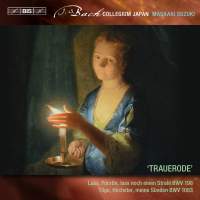Texte paru dans: / Appeared in: |
|
|
Outil de traduction ~ (Très approximatif) |
|
|
Reviewer: George
Chien Not having reviewed all of Masaaki Suzuki’s Bach cantatas, I was surprised to discover that Suzuki, unlike most of his counterparts, did not include Cantata 198 in his edition. He had a valid excuse: the Trauer Ode was not a sacred (read “church”) cantata. It was composed for the elaborate state funeral in 1727 of Christiane Eberhardine, the popular Electress of Saxony. The memorial was instigated by a private individual but gained support from all segments of the Leipzig community. As a composer, Bach, of course, made no distinction between “sacred” and “secular.” Three years later he reworked much of this cantata for his now lost St. Mark Passion. Now more accurately classified, the Trauer Ode makes it appearance in Suzuki’s survey of the secular cantatas, coupled here with two curious but fascinating disc mates. Schlage doch is an isolated aria, probably from a cantata otherwise lost, that was erroneously attributed to Bach and given the BWV number 53. It is now tentatively attributed to an older Leipzig contemporary, Georg Melchior Hoffmann (c. 1679–1715), who, incidentally, also wrote another cantata (BWV 189) that was misattributed to Bach. Schlage doch’s popularity, thanks in part to its tolling bell, has exempted it from the instant oblivion that so often accrues to pieces discovered not to be the work of more famous composers. Tilge, Höchster is not, and is, by Bach. It is an arrangement by him of the very famous Stabat Mater by Giovanni Battista Pergolesi (1710–1726). Why Bach made this arrangement is not clear; presumably it was commissioned. At the time, about 1746, Pergolesi was probably more highly esteemed than Bach, and it’s likely that Bach was aware of that. The Stabat Mater was (and is) one Western music’s great treasures, a forerunner of the new style that would eclipse the high Baroque of Bach. It was also unsuitable for use in a Protestant setting, so Bach’s task was to fit Pergolesi’s music to a new German text. That, as we know, was the sort of thing that was second nature to Bach, who, it must be said, was not above making small improvements while tweaking the original. Suzuki’s
performances are, as expected, masterful. Like Bach, his dedication to the
secular side is no less than to the sacred. His soloists are splendid
throughout. Joanne Lunn is superb in the Trauer Ode, and Carolyn Sampson is,
if it’s possible, even better in the Pergolesi remake—much like her partner,
Robin Blaze, who is equally compelling in Schlage doch. This is a marvelous
disc. Congratulations all around! | |
|
|
|
|
Cliquez l'un ou l'autre
bouton pour découvrir bien d'autres critiques de CD |
|




